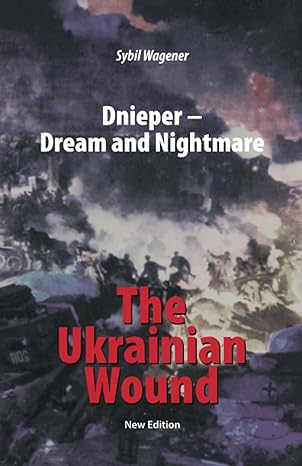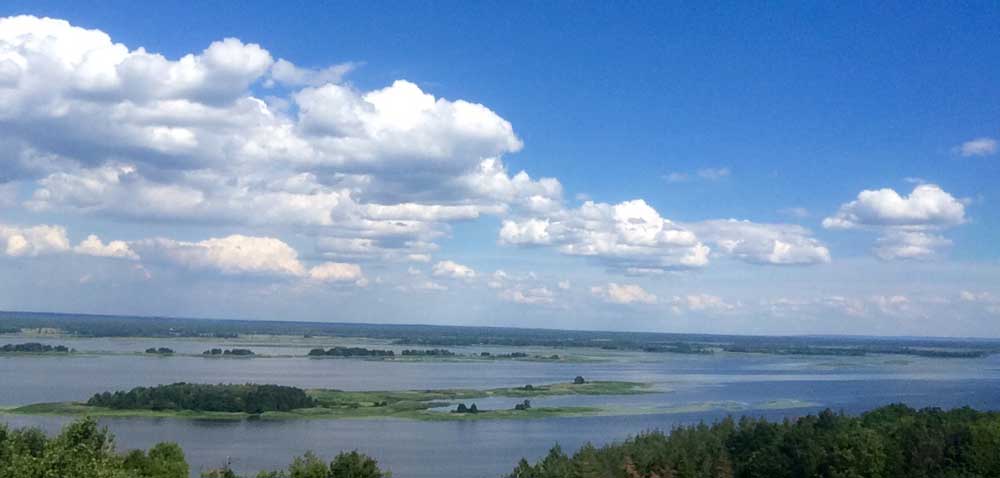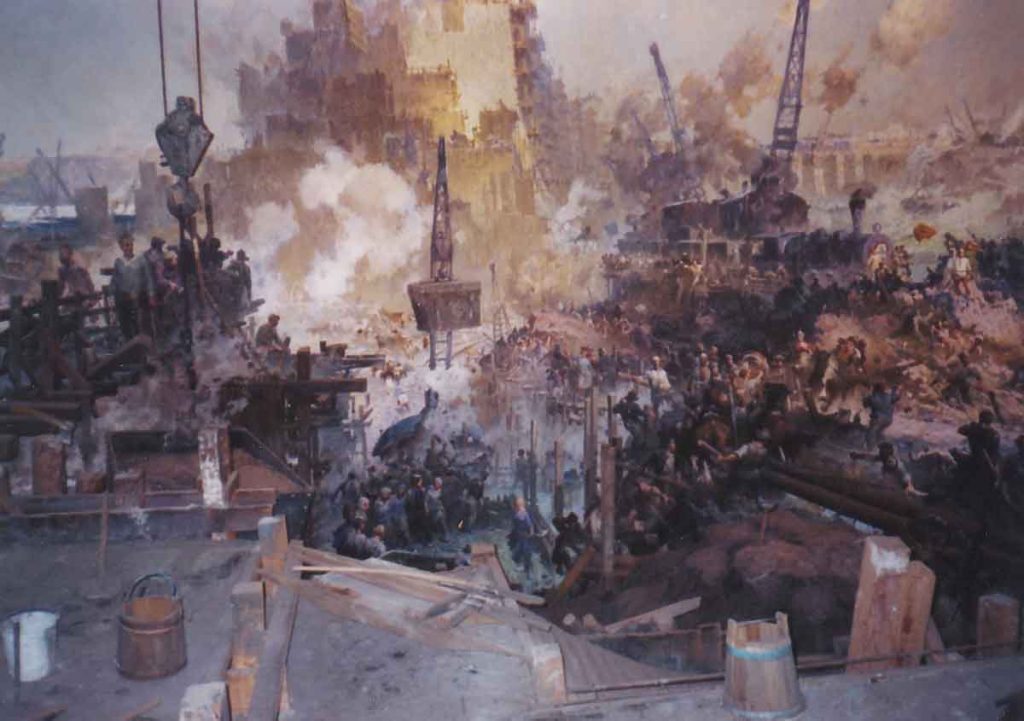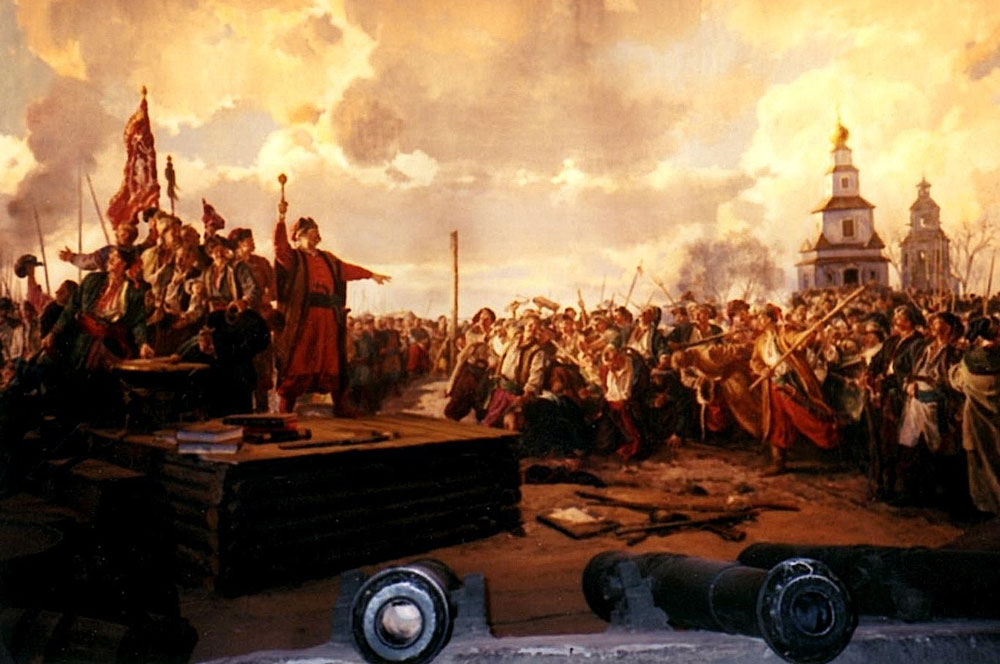On the occasion of a cruise on the Dnieper River, the narrator reflects on the several thousand year old history of the Urkraine.
The book describes Ukraine as a country that has freed itself from the Bolshevik grip and is becoming aware of its several thousand years of history: Greek colony, Roman place of exile for Christians, cradle of Rus, hinterland of Black Sea pirates, stomping ground of Cossacks, destination of Crimean Tatars and scene of World War II.
Although Melanie, the author’s alter ego, originally explored the question of how much the memory of World War II has shaped the children of those soldiers who carried that war eastward as a transgenerational trauma, the perspective of this travel novel is optimistic, as she experienced a society on the move.

Dnieper – Dream and Nightmare: The Ukranian Wound
New Edition 2023 by Sybil Wagener
Order from the publisher or Amazon
Publisher: Das literarische Drehbuch
Karl-Marx-Allee 141, 10243 Berlin
Tel. +49 (0) 179 531 03 72
E-Mail: verlag@das-literarische-drehbuch.de
However, in the meantime world history took a new turn. The Russian-Ukrainian war is tearing apart what has belonged together longer and more bindingly than, for example, the socialist confederation of states that was dissolved in 1991. The close intertwining of Ukrainian and Russian history can be traced back to a geographic preconception: The primeval valley of the Dnieper River and its confluence with the Black Sea is an unchanging space of action that shapes not only people’s lives but also their consciousness, forcing them into a dependence on nature that can only be understood as myth – notwithstanding the overpresence of technology and its own projections. During her journey, Melanie tries to find words for the shock that this natural phenomenon triggers in her.
The Dnieper marks the border between Central and Eastern Europe, between cultivated and wild land; coming from the west, it strikes a new topographical note: Endlessness. It is nothing like our Central European rivers, nestled between narrow banks, which give a special accent to a valley. Here the river is the landscape: gigantic masses of water in unstoppable motion. On the map it looks like the body of a full-blown blue cobra. It is the surrounding countryside that the river has assimilated. Even where it is not dammed into huge lakes, it occupies gigantic space, widened by countless islands and sandbanks.

Seen from the shore, it is formidable even at its narrowest points; a natural obstacle to invading armies. It became one of those conquest myths that inspire commanders and soldiers in wartime. Hitler imagined that the war would be won as soon as the Wehrmacht crossed the river. Stalin ordered the Dnieper line to be held at all costs.
Kiev had been defended by eleven Soviet divisions. The Germans had besieged it for appearances to hide their real plan. High in the north and low in the south, their armored armies were to cross the Dnieper and trap the Soviet troops.
P. 38
Large units of troops were trapped and bombed.The Dnieper myth became the Red Army’s undoing.
Melanie evades the memory of the war atrocities that occurred on the shore by focusing on the changements of the water surface.
“The Borysthenes glided over a lead-silver expanse of water, bordered in the distance by dark lines. Sometimes the shores came closer, or it was an island approaching, in the sandy bays figures could be seen bathing or entertaining fires. Behind the undeveloped shores and matted groves, she imagined the endless steppe stretching from the Dnieper to the Urals. She leaned over the railing and stared into the water, which appeared jet black beneath the flashing surface. Sailing the river for days on a boat she had imagined would be a process of disengagement that might end with her grasping the essence of this landscape, but now she felt like an uninvolved bystander. There was too much technology between her and nature, the vibration of the engines preventing symbiosis. She would have liked to swap places with the fishermen, who squatted in their tiny boats, ignoring the ship. But what looked like a twinning of spirit and water could also be an evil spell, for all the lines hung slack, no fish swam or jumped in sight.
P. 53

Saporoshje
The first stop on the cruise evoked memories of its own for Melanie. Soldiers on leave are interrogated by their families…
Melanie saw the tips of the tablecloth, the chair legs and her father’s shiny boots clearly in front of her. Children who seem to be absorbed in their play on the floor don’t miss a word of the adults’ conversation, even if they don’t understand the context. They remember words that occur frequently and those that are pronounced with particular emphasis. One word for which both were true – frequency and emphasis – was Zaporozhye. What a soft, tender-sounding name for a city that could not be more brittle! Apartment blocks of gray, crumbling concrete along a double-lane taxiway, Lenin Prospekt. Neglected, weed-covered green spaces that are not urban luxury but steppe remnants. The spaciousness of socialist construction appeared to her once again as an expression of inconsideration towards the people, whose remaining strength is to be fully exhausted by long walks after work. Friedrich Engels had emphasized the revolutionary potential of dense residential quarters in industrial cities, where workers live so close together that they can conspire in their neighborhood. This seems to be deliberately undermined by socialist housing with its isolated residential towers and steppe-like open spaces. Nowhere even a bush, let alone a shady group of trees or a bench to rest on.
P 57
The power plant
In Zaporozhye, the Borysthenes docked to allow a visit to the Cossack Museum. Teresa, the tour guide, commented on the tour along the display cases. Melanie, too impatient to listen to lectures, separated herself by either staying a few steps back or leading the way to the next display case. An opening in the wall caught her eye, a low archway behind which the light shimmered mysteriously. When Teresa was distracted for a moment, she slipped inside.
The passageway opened onto an illuminated, semi-circular panoramic painting. Full of realistic detail and easily decipherable messages, it showed the construction site of the power plant as a seething, smoking, steaming witch’s kitchen of engineering. From the background on the right, where it appeared small and distant, the dam wall had been brought forward, compressed in perspective, and set against the sky as a modern Tower of Babel. Staggered scaffolding, half-finished construction sections above yawning depths created the illusion of space. From a freshly concreted platform at the viewer’s feet, the view fell into the drained riverbed of the Dnieper, from which mystical plumes of steam rose. Tiny people swarmed around the cranes and locomotives. Everything seemed cheerful and light. The workers, whether they were laying pipes, driving piles, carrying loads, unloading cranes, moved with the elegance of dancers. In the center of the picture, women with shovels formed a well-composed semicircle into which an iron tub of concrete was being lowered from a crane. They were painted, with short, tight-fitting skirts over their boots, with enticing curves. Work is Eros, was the message. In reality, it was hard labor under grueling conditions..But the goal was achieved: in 1932, the power plant went online.
P. 59

Here, on the lower reaches of the Dnieper, the new Russia had begun, which Stalin had ordered to catch up in a decade with what the West had had more than a century to achieve – industrialization. For the communist visionaries, the Soviet Republic of Ukraine, with the water power of its rivers and its mineral resources, the manganese ore mines of Nikopol, the iron ore mines of Krivoy-Rog, the coal basins and iron districts of the Donets, became the Promised Land of progress).
P. 59
With the myth of building a society of just distribution, Stalin transferred the principle of drudgery from the system of serfdom to the system of party dictatorship.
A reservoir was created near Zaporozhye, under whose waters disappeared the thirteen rapids, notorious since ancient times, which Catherine’s flotilla had had to overcome on its way to the Black Sea. The Fama does not forget them. They symbolize the sacrifice of nature demanded by modernity.
In the vestibule, where a school class was just gathering, Melanie approached the tour guide about the panorama.
“This is local history with a preface and an epilogue from Moscow,” she said. The museum tour for the children of Zaporozhye begins with the industrialization of Ukraine, culminating in the construction of the power plant, and ends with the victory over fascism. In between, they are led along display cases with shimmering gold grave goods and hear about the kingship of the Scythians. Daggers, saddles, fur hats, tights are the illustrative material for the history of the Zaporozhian Sec, the legendary Cossack society. At least they learn that their ancestors were Scythians and Cossacks and that Ukrainian history was not written in Moscow – which was the official doctrine until recently’. Melanie felt there was more to say about this. What the children did not learn, she asked. “That they are free people”.
P. 58/59
Cossacks
Myth of freedom… In the next brightly painted, theatrically illuminated panoramic cave, they were faced with a dramatic scene: under threatening massed cloud formations, a man with a moustache, turban and pluder pants was imperiously wielding a scepter on a pedestal. His rule seems to be threatened, for around the pedestal, in the costumes of 1001 Nights, a crowd armed with clubs and sticks rages. Even realistic paintings do not always explain themselves. Where do you think this scene is taking place?” Teresa asked her audience. ‘In the Orient,’ one replied. ‘In the Crimea,’ another. ‘In the Zaporozhian Sec.’ This was the little man in the peaked cap who always spoke up in German. ‘What you’re looking at here,’ Teresa said excitedly, ‘is the deposing of a leader by the people.’ The Sec was something of a model democratic society. Free men – that’s all the word Cossack means: free man – gathered in the open air to elect or, as in this case, vote out their hetman. To the right of the picture, surrounded by dignitaries, the new candidate waits calmly. Elected by the subjects, deselectable by the subjects. In the 16th century there was already free suffrage here in Ukraine’. – ‘Allow me to contradict you,’ said the little man. ‘That was not democracy, that was anarchy. A ragtag bunch of deserters and runaway peasants in the borderlands between the states. A kind of Wild West in the low forest of a thousand islands.’ Teresa threw her head back. “They were Christians! Orthodox! Mortal enemies of the Golden Horde! – ‘They were,’ the critic countered, ‘robbers and pirates. They rowed out into the Black Sea in their small boats and, like swarms of piranhas, pounced on every merchant ship that crossed their path. Their cruelty was legendary. Prisoners they did not take. Women were raped and murdered. Children were sold into slavery. They wore the captured clothes and weapons as trophies. Their freedom was a year-round bloodthirsty carnival.’ Red marks stood out on Teresa’s cheekbones. ‘They opposed the jihad of the Muslims with their holy war…Today the Cossacks represent free Ukraine more than any other population group. They are the hopefuls of our independence.’ – ‘God forbid,’ muttered the little man.
P. 62/63

Cossackism had previously appeared to Melanie as a kind of folklore, as a loving cultivation of traditional customs, comparable to Bavarian costume societies… Now she was confronted with a Ukrainian population whose roots are quasi prehistoric, created in a settlement vacuum, in the open steppe, where no fixed institutions could develop, where everything vital had to be mobile, each individual had to remain replaceable and only identification with the pack ensured survival. This generates a different mentality than an existence in the protection of walls and sets of rules; this means freedom as an open horizon without all barriers; but this also presupposes the binding nature of agreements, since nothing else constitutes social cohesion. Melanie believed that it was the Cossack heritage on which Stalin relied when he had the First and Second Ukrainian Armies fight to free their own country at the head of the Red Army.
Myth and reality
In the afternoon, when the majority of the passengers left for the ‘Cossack Show’, Melanie rolled her bathing suit into a towel and crossed the pedestrian bridge to get to the beach from the riverside road. The river was split in two here below the dam, flowing around a large island, and even as an arm it was wider than the Rhine at Karlsruhe… The white, fine-grained, clean sand was so hot it burned the soles of her feet. She dropped onto her towel and slipped on her shoes. In the short time it took her to rub on her UV protection cream, the sun was already becoming unbearable to her – in September! She noticed that the bathers all stayed close to the shore, so she first checked the water surface with her eyes to see if it was streaming or swirling before wading into the river. Incomparable is the feeling of diving in and being carried, of sinking without sinking… After all, it was not just any river that Melanie climbed into, it was the Dnjeper. She expected nothing less than symbiosis with a myth. The fertility goddess of the Greeks and Scythians, the guarantee of freedom of the Cossacks, the challenge of the engineers, the blue finish line of Hitler, the bastion of Stalin, the hope of the soldiers – all this was the Dnieper. Lying on her back, Melanie wanted to drift and feel one with the element that has the power to cleanse itself of everything: Blood, debris, dynamite. The shore was shallow, wading laborious under the aggressive sun. As soon as the water was knee-deep, she dropped. Half swimming, half crawling, she reached deeper places. Something brushed her legs and belly – water plants. Not the gently caressing leaves as in the rivers of her childhood, but hard, knotty, branching brush. Two or three more strokes, and Melanie was in the middle of an underwater forest. The feeling of having to trudge free became so compelling that she turned back. Now she also discovered small black particles on the surface of the water and was finally disillusioned. There was nothing great about bathing in the great stream, at least in this part. It wasn’t flowing freely, it was tied up, and who knows what was piling up here: contaminated sludge from Chernobyl, heavy metals and soluble toxins from the industrial centers on the upper reaches, incineration residues from the neighborhood, sewage from the satellite towns. She paddled, crawled and waded back to the shore, there she had to expose herself to the sun to put on her sneakers; her skin was burning when she finally reached the covered cottage. To the reports of her tablemates about the Cossacks’ riding skills (“like in a circus,” Magda praised) she had only five words to counter: “I was swimming in the Dnjeper.” No one attached any importance to this.
p. 68